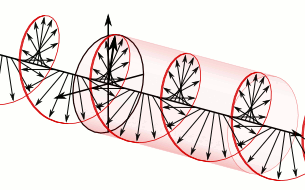|
Electromagnetic Brake
Electromagnetic brakes (also called electro-mechanical brakes or EM brakes) slow or stop motion using electromagnetic force to apply mechanical resistance (friction). They were originally called "electro-mechanical brakes," but over the years the name changed to "electromagnetic brakes", referring to their actuation method. Since becoming popular in the mid-20th century, especially in trains and trams, the variety of applications and brake designs has increased dramatically, but the basic operation remains the same. Both electromagnetic brakes and eddy current brakes use electromagnetic force, but electromagnetic brakes ultimately depend on friction whereas eddy current brakes use magnetic force directly. Applications In locomotives, a mechanical linkage transmits torque to an electromagnetic braking component. Trams and trains use electromagnetic track brakes where the braking element is pressed by magnetic force to the rail. They are distinguished from ''mechanical'' track brak ... [...More Info...] [...Related Items...] OR: [Wikipedia] [Google] [Baidu] |
Electromagnetism
In physics, electromagnetism is an interaction that occurs between particles with electric charge. It is the second-strongest of the four fundamental interactions, after the strong force, and it is the dominant force in the interactions of atoms and molecules. Electromagnetism can be thought of as a combination of electricity and magnetism, two distinct but closely intertwined phenomena. In essence, electric forces occur between any two charged particles, causing an attraction between particles with opposite charges and repulsion between particles with the same charge, while magnetism is an interaction that occurs exclusively between ''moving'' charged particles. These two effects combine to create electromagnetic fields in the vicinity of charge particles, which can exert influence on other particles via the Lorentz force. At high energy, the weak force and electromagnetic force are unified as a single electroweak force. The electromagnetic force is responsible for many o ... [...More Info...] [...Related Items...] OR: [Wikipedia] [Google] [Baidu] |
AlNiCo
Alnico is a family of iron alloys which in addition to iron are composed primarily of aluminium (Al), nickel (Ni), and cobalt (Co), hence the acronym ''al-ni-co''. They also include copper, and sometimes titanium. Alnico alloys are ferromagnetic, and are used to make permanent magnets. Before the development of rare-earth magnets in the 1970s, they were the strongest type of permanent magnet. Other trade names for alloys in this family are: ''Alni, Alcomax, Hycomax, Columax'', and ''Ticonal''. The composition of alnico alloys is typically 8–12% Al, 15–26% Ni, 5–24% Co, up to 6% Cu, up to 1% Ti, and the rest is Fe. The development of alnico began in 1931, when T. Mishima in Japan discovered that an alloy of iron, nickel, and aluminium had a coercivity of , double that of the best magnet steels of the time. Properties Alnico alloys can be magnetised to produce strong magnetic fields and have a high coercivity (resistance to demagnetization), thus making strong permanent magn ... [...More Info...] [...Related Items...] OR: [Wikipedia] [Google] [Baidu] |
Electromagnetism
In physics, electromagnetism is an interaction that occurs between particles with electric charge. It is the second-strongest of the four fundamental interactions, after the strong force, and it is the dominant force in the interactions of atoms and molecules. Electromagnetism can be thought of as a combination of electricity and magnetism, two distinct but closely intertwined phenomena. In essence, electric forces occur between any two charged particles, causing an attraction between particles with opposite charges and repulsion between particles with the same charge, while magnetism is an interaction that occurs exclusively between ''moving'' charged particles. These two effects combine to create electromagnetic fields in the vicinity of charge particles, which can exert influence on other particles via the Lorentz force. At high energy, the weak force and electromagnetic force are unified as a single electroweak force. The electromagnetic force is responsible for many o ... [...More Info...] [...Related Items...] OR: [Wikipedia] [Google] [Baidu] |
Railway Brakes
A railway brake is a type of brake used on the cars of railway trains to enable deceleration, control acceleration (downhill) or to keep them immobile when parked. While the basic principle is similar to that on road vehicle usage, operational features are more complex because of the need to control multiple linked carriages and to be effective on vehicles left without a prime mover. Clasp brakes are one type of brakes historically used on trains. Early days In the earliest days of railways, braking technology was primitive. The first trains had brakes operative on the locomotive tender and on vehicles in the train, where "porters" or, in the United States brakemen, travelling for the purpose on those vehicles operated the brakes. Some railways fitted a special deep-noted brake whistle to locomotives to indicate to the porters the necessity to apply the brakes. All the brakes at this stage of development were applied by operation of a screw and linkage to brake blocks applied ... [...More Info...] [...Related Items...] OR: [Wikipedia] [Google] [Baidu] |
Brakes
A brake is a mechanical device that inhibits motion by absorbing energy from a moving system. It is used for slowing or stopping a moving vehicle, wheel, axle, or to prevent its motion, most often accomplished by means of friction. Background Most brakes commonly use friction between two surfaces pressed together to convert the kinetic energy of the moving object into heat, though other methods of energy conversion may be employed. For example, regenerative braking converts much of the energy to electrical energy, which may be stored for later use. Other methods convert kinetic energy into potential energy in such stored forms as pressurized air or pressurized oil. Eddy current brakes use magnetic fields to convert kinetic energy into electric current in the brake disc, fin, or rail, which is converted into heat. Still other braking methods even transform kinetic energy into different forms, for example by transferring the energy to a rotating flywheel. Brakes are generally ... [...More Info...] [...Related Items...] OR: [Wikipedia] [Google] [Baidu] |
Dynamic Braking
Dynamic braking is the use of an electric traction motor as a generator when slowing a vehicle such as an electric or diesel-electric locomotive. It is termed " rheostatic" if the generated electrical power is dissipated as heat in brake grid resistors, and " regenerative" if the power is returned to the supply line. Dynamic braking reduces wear on friction-based braking components, and regeneration lowers net energy consumption. Dynamic braking may also be used on railcars with multiple units, light rail vehicles, electric trams, trolleybuses, and electric and hybrid electric automobiles. Principle of operation Converting electrical energy to the mechanical energy of a rotating shaft (electric motor) is the inverse of converting the mechanical energy of a rotating shaft to electrical energy (electric generator). Both are accomplished through the interactions of armature windings with a (relatively) moving external magnetic field, with the armature connected to an electrical ... [...More Info...] [...Related Items...] OR: [Wikipedia] [Google] [Baidu] |
Eddy Current Brake
An eddy current brake, also known as an induction brake, electric brake or electric retarder, is a device used to slow or stop a moving object by generating eddy currents and thus dissipating its kinetic energy as heat. Unlike friction brakes, where the drag force that stops the moving object is provided by friction between two surfaces pressed together, the drag force in an eddy current brake is an electromagnetic force between a magnet and a nearby conductive object in relative motion, due to eddy currents induced in the conductor through electromagnetic induction. A conductive surface moving past a stationary magnet develops circular electric currents called eddy currents induced in it by the magnetic field, as described by Faraday's law of induction. By Lenz's law, the circulating currents create their own magnetic field that opposes the field of the magnet. Thus the moving conductor experiences a drag force from the magnet that opposes its motion, proportional to its veloc ... [...More Info...] [...Related Items...] OR: [Wikipedia] [Google] [Baidu] |
Regenerative Brake
Regenerative braking is an energy recovery mechanism that slows down a moving vehicle or object by converting its kinetic energy into a form that can be either used immediately or stored until needed. In this mechanism, the electric traction motor uses the vehicle's momentum to recover energy that would otherwise be lost to the brake discs as heat. This method contrasts with conventional braking systems. In those systems, the excess kinetic energy is converted to unwanted and wasted heat due to friction in the brakes, or with rheostatic brakes, where the energy is recovered by using electric motors as generators but is immediately dissipated as heat in resistors. In addition to improving the overall efficiency of the vehicle, regeneration can significantly extend the life of the braking system as the mechanical parts will not wear out quickly. General principle The most common form of regenerative brake involves an electric motor functioning as an electric generator. In elect ... [...More Info...] [...Related Items...] OR: [Wikipedia] [Google] [Baidu] |
Electromagnetic Clutch
Electromagnetic clutches operate electrically but transmit torque mechanically. This is why they used to be referred to as electro-mechanical clutches. Over the years, EM became known as electromagnetic versus electro-mechanical, referring more about their actuation method versus physical operation. Since the clutches started becoming popular over 60 years ago, the variety of applications and clutch designs has increased dramatically, but the basic operation remains the same today. Single-face clutches make up approximately 90% of all electromagnetic clutch sales. Electromagnetic clutches are most suitable for remote operation since no mechanical linkages are required to control their engagement, providing fast, smooth operation. However, because the activation energy dissipates as heat in the electromagnetic actuator when the clutch is engaged, there is a risk of overheating. Consequently, the maximum operating temperature of the clutch is limited by the temperature rating of th ... [...More Info...] [...Related Items...] OR: [Wikipedia] [Google] [Baidu] |
Brake Run
A brake run on a roller coaster is any section of track meant to slow or stop a roller coaster train. Brake runs may be located anywhere along the circuit of a coaster and may be designed to bring the train to a complete halt or to simply adjust the train's speed. Contrary to some belief, the vast majority of roller coasters do not have any form of braking on the train itself, but rather forms of braking that exist on track sections. One notable exception is the Scenic Railway roller coaster, which relies on an operator to manually control the speed of the train. On most roller coasters, the brakes are controlled by a computer system. Some older coasters have manually operated friction or skid brakes, some with a pneumatic assist. These are either engaged at the control panel or operated by pulling or pushing large levers in the station. Trim brakes Trim brakes are sections of brakes which are intended to adjust a train's speed during its course rather than bring the train to ... [...More Info...] [...Related Items...] OR: [Wikipedia] [Google] [Baidu] |
Electromagnetic Hysteresis Power Brake
In physics, electromagnetism is an interaction that occurs between particles with electric charge. It is the second-strongest of the four fundamental interactions, after the strong force, and it is the dominant force in the interactions of atoms and molecules. Electromagnetism can be thought of as a combination of electricity and magnetism, two distinct but closely intertwined phenomena. In essence, electric forces occur between any two charged particles, causing an attraction between particles with opposite charges and repulsion between particles with the same charge, while magnetism is an interaction that occurs exclusively between ''moving'' charged particles. These two effects combine to create electromagnetic fields in the vicinity of charge particles, which can exert influence on other particles via the Lorentz force. At high energy, the weak force and electromagnetic force are unified as a single electroweak force. The electromagnetic force is responsible for many of t ... [...More Info...] [...Related Items...] OR: [Wikipedia] [Google] [Baidu] |








